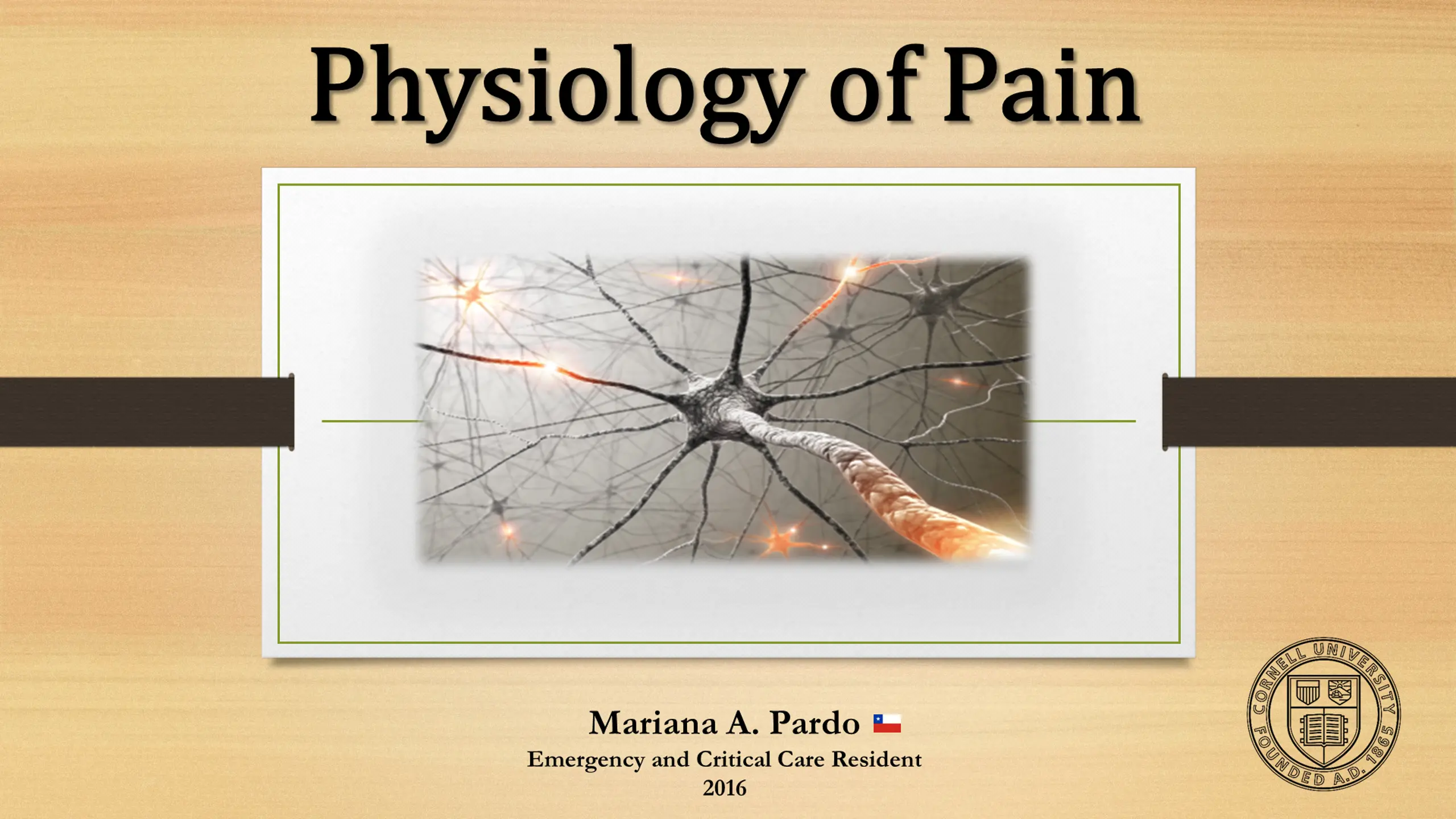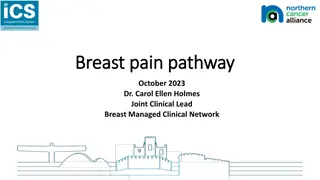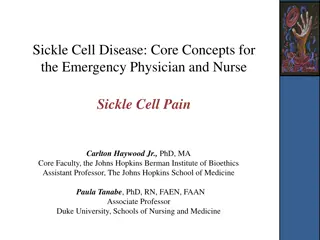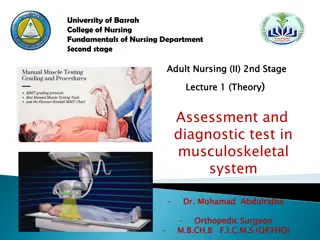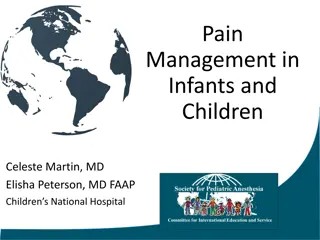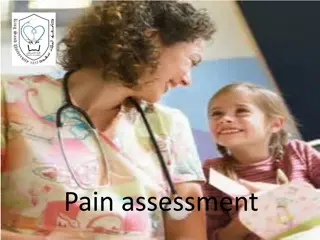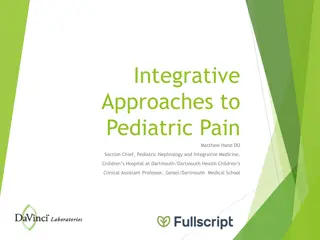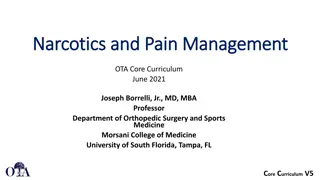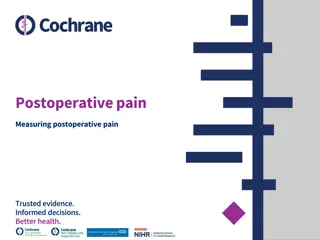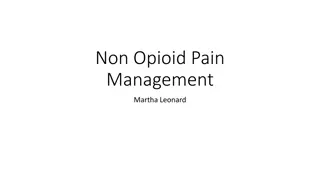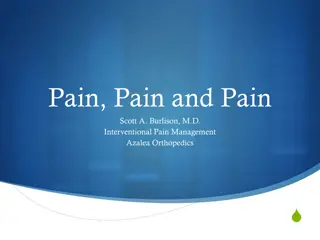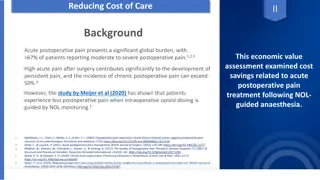Physiology of Pain
The physiology of pain, including its definition, types, causes, nociceptive pathway, transmission, and more. Gain a comprehensive understanding of pain terminology and different phases of nociceptive pain.
Download Presentation

Please find below an Image/Link to download the presentation.
The content on the website is provided AS IS for your information and personal use only. It may not be sold, licensed, or shared on other websites without obtaining consent from the author.If you encounter any issues during the download, it is possible that the publisher has removed the file from their server.
You are allowed to download the files provided on this website for personal or commercial use, subject to the condition that they are used lawfully. All files are the property of their respective owners.
The content on the website is provided AS IS for your information and personal use only. It may not be sold, licensed, or shared on other websites without obtaining consent from the author.
E N D
Presentation Transcript
Physiology of Pain Physiology of Pain Mariana A. Pardo Emergency and Critical Care Resident 2016
Definition of Pain Types of Pain Causes of Pain Nociceptive Pathway Types of Pain Transmission 4 Phases of Nociceptive Pain Pain Stimuli Afferent Fibers Ascending Pathways Gate Control Theory Descending Pathways Summary Pain Terminology
an unpleasant sensory and emotional experience associated with actual or potential tissue damage or described in terms of such damage Definition of Pain
Types of Pain Acute Chronic Occurs immediately after a stimulus is received Severity can vary Responds well to treatment Subsides once stimulus is removed Persists past initial stimulus (3-6 months) Severity can vary May or may not respond well to treatment; may require a multi-modal approach Can result in allodynia, hyperalgesia, and opioid tolerance
Causes of Pain Inflammation of nerves (i.e.: trigeminal neuritis) Injury of nerves with scar formation (i.e.: surgical damage) Nerve invasion by cancer Injury to thalamus or cortical areas that process pain information (i.e.: spinal trauma) Abnormal activity in the nerve circuits that is perceived as pain (i.e.: phantom pain) http://www.natural-dog-health-remedies.com/dog-back-problems.html
Nociceptive Pathway Nociception: stimulation of sensory nerve cells called nociceptors, which produce a signal that travels along a chain of nerve fibers via the spinal cord to the brain 3 Neuron Pathway: 1st neuron the primary afferent neuron transduction of noxious stimuli and conduction of signals from the peripheral tissues to neurons in the dorsal horn of the spinal cord. 2nd neuron the projection neuron receives input from the primary afferent neurons and projects to neurons in the medulla, pons, midbrain, thalamus, and hypothalamus. 3rd neuron supraspinal neurons integrate signals from the spinal neurons and project to the subcortical and cortical areas where pain is finally perceived
Physiologic Structures: Organs and linings of body cavities Mechanism: Activation of nociceptors Characteristics: Poorly localized, diffuse, deep, cramping or splitting Sources of Acute Pain: Chest tubes, abdominal drains, bladder and intestinal distention Sources of Chronic Pain: Pancreatitis, liver metastases, colitis Visceral Nociceptor http://clinicalgate.com/back-and-neck-pain/
Physiologic Structures: Cutaneous: Skin and SQ tissues Deep Somatic: blood vessels, muscle, connective tissue Mechanism: Activation of nociceptors Characteristics: Well-localized, constant, achy Sources of Acute Pain: Incisions, insertion site of tubes and drains, wound complications, orthopedic procedures, skeletal muscle spasms Sources of Chronic Pain: Bony metastases, arthritis, low-back pain Somatic Nociceptor http://clinicalgate.com/back-and-neck-pain/
Physiologic Structures: Nerve fibers, spinal cord, CNS Mechanism: Non-nociceptive injury to nervous system structures Characteristics: Generalized along distribution of damaged nervous structures Sources of Acute Pain: Poorly localized, shooting, burning, fiery, shock-like, sharp, painful numbness Sources of Chronic Pain: Nervous tissue injury due to diabetes, chemotherapy, neuropathies, post-therapeutic neuralgia, trauma, surgery Non-Nociceptor or Neuropathic http://clinicalgate.com/back-and-neck-pain/
Physiologic Structures: No organic structures Mechanism: Emotional Characteristics: Variable, often numerous Sources of Acute Pain: Nonorganic Sources of Chronic Pain: Nonorganic psychological factors Psychogenic
4 Phases of Nociceptive Pain Transduction Transmission Perception Modulation
4 Phases of Nociceptive Pain Transduction: substances are released by damaged tissues and lead to the generation of an action potential Chemical stimuli Thermal stimuli Mechanical stimuli
Chemical Stimuli Patel, 2010 Ringkamp et al, 2013
Transmission: action potential continues from the site of damage to the spinal cord, then ascends up the spinal cord to higher centers in the brain Peripheral afferent nociceptors A fibers A fibers C fibers Ascending Pathways Spinal Cord Spinothalamic Tract Pain and temperature Dorsal Column System Touch and proprioception 4 Phases of Nociceptive Pain
Primary Afferent Nerves: A- Nociceptor: Activated by light touch and/or moving stimuli Largest of the myelinated nerves 6-22 m diameter Fast with a conduction velocity of 33-75 m/s Primarily in skin, normally don t produce pain
Primary Afferent Nerves: A- Nociceptor: Activated by mechanical and thermal stimuli Smallest of the myelinated nerves 2-5 um diameter Fast with a conduction velocity of 6-30 m/s Short-lasting, pricking-type pain
Primary Afferent Nerves: C Nociceptor: Activated by mechanical, chemical and thermal stimuli Unmyelinated nerves 2 um diameter Slow conduction velocity of 0.5-2 um/s Dull, poorly localized, burning type pain
Primary Afferent Nerves: C Nociceptor: Divided into 2 classes: Peptidergic: expression of neuropeptides Substance P Calcitonin gene related peptide (CGRP) Neurokinin A Expresses receptors Nonpeptidergic: Expresses several receptors for neurotrophic factors and ion channels
Ascending Pathways Nociceptive fibers synapse with 2nd order neuron in the dorsal horn of the spinal cord. http://philschatz.com/anatomy-book/resources/1417_Ascending_Pathways_of_Spinal_Cord.jpg
Dorsal Horn 1storder neuron from the nociceptors goes to the dorsal horn and the rexed laminae Information travels to the contralateral ventral horn (Decussation)and then up the spinothalamic tract http://clinicalgate.com/back-and-neck-pain/
Rexed Laminae Lamina I - marginal layer Lamina II - substantia gelatinosa Lamina III nucleus proprius Lamina IV Lamina V wide range dynamic neurons
Ascending Pathways Pain information is then sent through the spinothalamic tract to the thalamus and through the spinomesencephalic tract to the periaqueductal grey (PAG) 2nd order neuron synapses with the 3rd order neuron and information is sent to the Somatosensory Cortex http://philschatz.com/anatomy-book/resources/1417_Ascending_Pathways_of_Spinal_Cord.jpg
Somatosensory Cortex 3rdorder neuron then sends information to the appropriate area of the Homunculus of the Primary Somatosensory Cortex http://biology-forums.com/index.php?topic=93010.0
Ascending Pathways 2ndorder neuron from laminae II, IV and V synapse with Reticular Activating System (RAS) in the brainstem relaying information: Touch, vibration and limb proprioception RAS has projections to medial thalamus and limbic system: Mediates motor, autonomic, endocrine and emotional response to pain 2ndorder neuron from laminae I and V synapse with pons, medulla, midbrain, Periaqueductal grey (PAG) and thalamus
4 Phases of Nociceptive Pain Perception: conscious awareness of pain
Limbic System Cingulate gyrus: behavior and emotion Amygdala: conditioned fear, anxiety Hippocampus: memory Hypothalamus: sympathetic autonomic activity Locus ceruleus: arousal, vigilance, behavior http://webspace.ship.edu/cgboer/limbicsystem.html
4 Phases of Nociceptive Pain Modulation: neurons descending from the brain release substances that inhibit the transmission of painful impulses and produce motor responses to avoid pain
Endogenous Mechanism of Pain Modulation 3 Main Mechanisms: Descending Inhibitory Nerve System Endogenous Opioid System Segmental Inhibition or Gate Control Theory Excitatory Nerve System https://www.painmanagementlosangeles.com/pain-management-clinics-in-los-angeles.html
Descending Inhibitory Nerve System Control the ascent of nociceptive information to the brain: Periaqueductal gray matter (PAG) Rostral ventromedial medulla (RVM) Main transmitters: Serotonin Norepinephrine http://www.physio-pedia.com/File:Descending-inhibitory-pathway.jpg
Endogenous Opioid System 3 Groups of Endogenous Compounds: Enkephalins Endorphins Dynorphins
Peripheral Modulators of Nociception On terminals of nociceptors Modulate voltage gated Ca2+ and decrease Ca2+entry Inhibition of neurotransmitter release and pain pathways
Summary Ascending Pathways Nociceptor Dorsal Horn Spinothalamic Tract Somatosensory Cortex Spinomesencephalic Tract PAG Rostral ventral medulla Descending Pathways PAG Rostral ventral medulla Dorsal Horn Inhibitory pathway Excitatory pathway
References Hellyer, Peter, et al. "AAHA/AAFP pain management guidelines for dogs and cats." Journal of Feline Medicine & Surgery 9.6 (2007): 466-480. Kopf, Andreas, and N. B. Patel. "Guide it Pain Management in Low Resource Settings." (2009). Lemke, Kip A. "Understanding the pathophysiology of perioperative pain." The Canadian Veterinary Journal 45.5 (2004): 405. McMahon, Stephen, et al. Wall & Melzack's Textbook of Pain. Elsevier Health Sciences, 2013. Muir III, William W., and Clifford J. Woolf. "Mechanisms of pain and their therapeutic implications." Journal of the American Veterinary Medical Association 219.10 (2001): 1346-1356. Valtolina, Chiara, and Robert Goggs. "Pain Recognition and Management." Advanced Monitoring and Procedures for Small Animal Emergency and Critical Care (2012): 523-539. Wiese, A. Pain Pathways. IVECCS MDR Indianapolis, IN, 2014.
